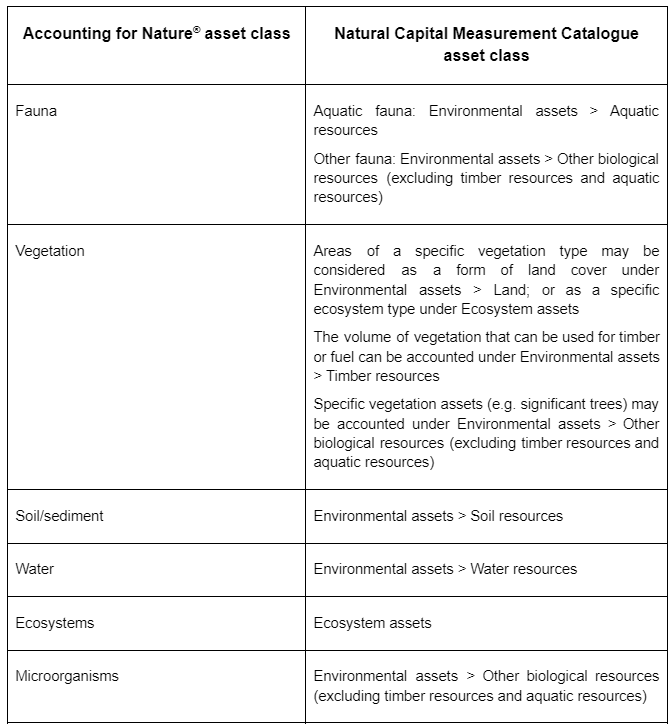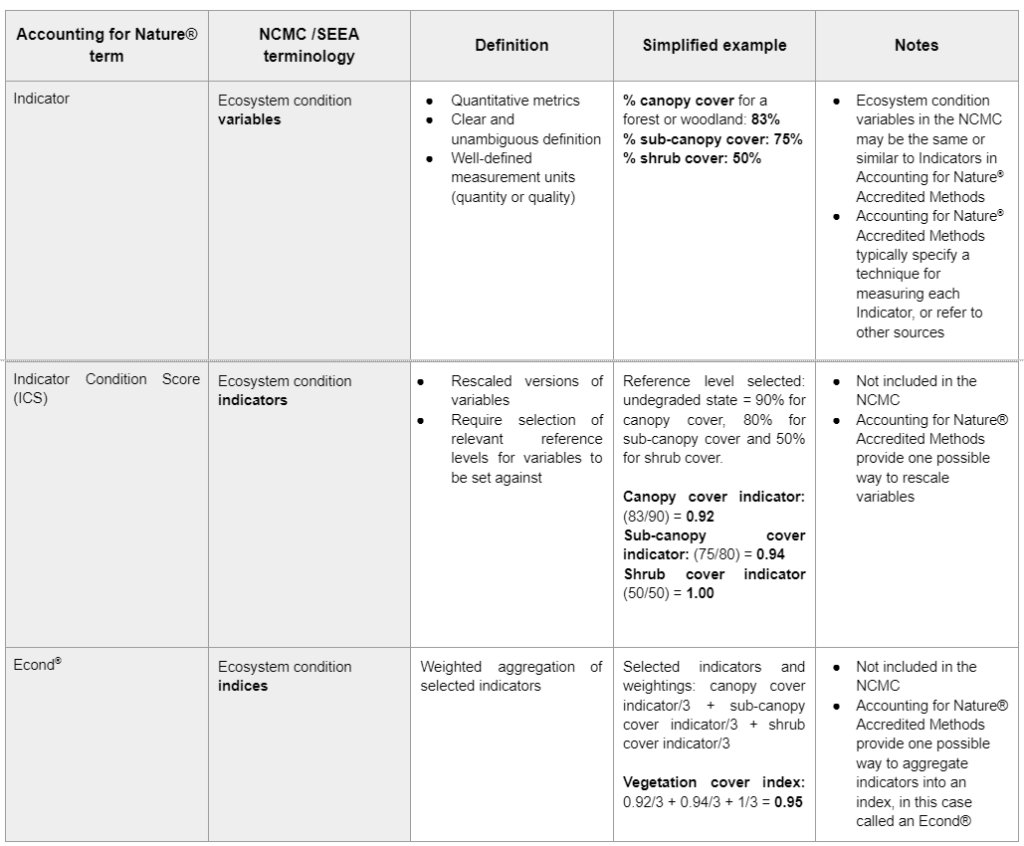The Natural Capital Measurement Catalogue (NCMC) is an open library of publicly available and widely used metrics and methods for measuring natural capital, from which a wide range of users can select and adapt the metrics and methods for their particular purpose. The NCMC is aligned with the United Nations System of Environmental-Economic Accounting (SEEA), the Natural Capital Protocol and the Recommendations of the Taskforce on Nature-related Financial Disclosures. It can also potentially be aligned with or contain references to metrics and methods derived from a variety of other natural capital accounting, assessment and reporting frameworks. However, users of the NCMC should be aware that each framework may have its own terms, definitions, and rules, for example governing when claims may be made to be following or complying with a certain framework. This document explains some of the background and limitations on using methods from one such framework, the Accounting for Nature® Framework.
Accounting for Nature Ltd (AfN) is a non-governmental organisation that provides a Framework for measuring, verifying, certifying, and publicly reporting Environmental Condition Accounts (Environmental Accounts). The Accounting for Nature® Framework includes methods for measuring the environmental condition of Environmental and Ecosystem Assets, as well as rules for using the Accounting for Nature® brand. Accounting for Nature methods can be found in the Accounting for Nature® Method Catalogue. Before using an Accounting for Nature® Method, users should read the following guidance.
IMPORTANT. Any Indicator from an Accounting for Nature® Accredited Method, must be read in the context of the respective Accounting for Nature® Accredited Method.
Users are not permitted to publicly state or imply that they are measuring ‘Accounting for Nature® variables’ unless they fully apply an Accredited Method to develop and obtain certification of an Environmental Account, or as otherwise mandated by Accounting for Nature Ltd or its designated agents or affiliates.
A reference in the Natural Capital Measurement Catalogue to an Accounting for Nature® Accredited Method is for information only and does not entail a recommendation or endorsement thereof, or imply that other measurement methods are not suitable for any given variable. Climateworks Centre does not guarantee that the method used to measure a variable in an Accounting for Nature® Accredited Method, or in further material referenced in such methods, is appropriate for all users or applications. Users should consider their own needs and context as well as the requirements around any claims made regarding use of Accounting for Nature® Accredited Methods (see below), including those that may be required by Accounting for Nature Ltd, its affiliates or agents, before making any use of Accounting for Nature® Accredited Method material. By using the NCMC, including any material referencing in any way the Accounting for Nature® Framework, Accounting for Nature® Accredited Methods or Accounting for Nature Ltd, you agree that you have read and understood and are subject to the Natural Capital Measurement Catalogue Terms and Conditions.
What is the Accounting for Nature® Framework?
The Accounting for Nature® Framework provides a system for measuring, verifying, certifying, and publicly reporting Environmental Condition Accounts (Environmental Accounts). Accounting for Nature® Certified Environmental Accounts can be used for a range of different purposes and claims such as (but not limited to) underpinning nature-credit issuance and environmental co-benefits associated with carbon credits, reporting of nature-related outcomes, evidencing green claims, ensuring market access, and informing improved management decisions.
In the Accounting for Nature® Framework, Environmental Accounts are comprised of individual Environmental Asset Accounts, for example, an Asset Account for a grassland and an Asset Account for a fauna species. Environmental Assets generally fall into one of the following Asset Classes that comprise broad components of the environment and are used for reporting and aggregation purposes: fauna, vegetation, soil/sediment, water, ecosystems, and microorganisms.
Accounting for Nature® Asset Accounts report the Environmental Condition for a particular Environmental Asset and are developed following an Accounting for Nature® Accredited Method.
What is an Accounting for Nature® Accredited Method?
Accounting for Nature® Accredited Methods are an essential component of the Accounting for Nature® Framework as they provide specific detailed instructions on how to measure and monitor the condition of a specific Environmental Asset in a consistent and comparable way. Importantly, every Accredited Method contains a relevant and appropriately comprehensive set of Indicators (called ‘ecosystem condition variables’ in the terminology of the SEEA standard) that together represent the Condition of an Environmental Asset. The Method provides specific instructions on the techniques required to measure each Indicator.
In the Accounting for Nature® Framework, the Condition of an Environmental Asset is summarised (using the Indicators) into a single score, the Econd® (or environmental condition index). The Econd® is the core metric used in all Asset Accounts under the Accounting for Nature® Framework. It is a composite index between 0 and 100, where 100 represents the Condition of an Environmental Asset in its undegraded (natural or best-on-offer) state. It allows the condition of different Environmental Assets in different places, measured at different times and scales, to be easily understood, compared, and communicated – no matter where in the world they are located. By repeatedly implementing a Method, the trend in the condition of an Environmental Asset can be assessed and clearly communicated via a Certified Environmental Account.
To calculate an Econd®, each Indicator is scored separately to produce an Indicator Condition Score (ICS) (or ‘ecosystem condition indicator’ in SEEA terms). The ICS is an index between 0 and 100, where 100 describes the reference state of the indicator. ICSs are then combined to calculate the Econd® (an ‘ecosystem condition index’ in SEEA terms). Econd® can also be aggregated, often using area-weighted averages, as defined in an Accredited Method.
Accounting for Nature® and SEEA Terminology
The Accounting for Nature® Framework outlines three Accuracy Levels that describe the expected accuracy of an Accredited Method and the resulting Econd® of the Asset Account. Each Accuracy Level is suited to a different purpose, end-use or claim. End-uses such as monetisation, unitisation and green claims typically require Asset Accounts developed at a higher Accuracy Level than Asset Accounts created to inform management decisions or demonstrate environmental outcomes. For more information on using an Accounting for Nature® Accredited Method to develop an Environmental Account please visit the AfN Website.
How are Accounting for Nature® Accredited Methods developed and accredited?
Accounting for Nature® Methods can be developed by anyone for accreditation under the Framework. As part of the accreditation process, all Methods undergo a rigorous review process by AfN and the Independent Science Committee (Committee). The Committee assesses the scientific rigor of a Method and ultimately recommends to Accounting for Nature Ltd whether the Method is suitable for accreditation under the Framework.
Why are Accounting for Nature® Methods referenced in the Natural Capital Measurement Catalogue?
The Natural Capital Measurement Catalogue (NCMC) includes numerous ecosystem condition variables drawn from a variety of sources, some of which are the same or similar to Indicators used in Accounting for Nature® Accredited Methods. Where this is the case, users of the NCMC may wish to consult the relevant Accounting for Nature® Accredited Method for further information on specific technique(s) for measuring that particular Indicator. The Accounting for Nature® Accredited Method may in turn refer the user to further references or data sources.
Users of the NCMC may note that Accounting for Nature® Environmental Asset Classes are not identical to the Environmental Asset categories listed in the NCMC, which are derived from the United Nations SEEA framework. However, they can be aligned or cross-referenced to the SEEA framework asset classes, as illustrated in the table below. Users of the NCMC may also observe some differences in terminology between the Accounting for Nature® Framework and the NCMC, which uses terminology for ecosystem condition measurement from the SEEA standard. However, these different terms can be aligned, as explained in the table below.

Accounting for Nature® Framework and Natural Capital Measurement Catalogue (NCMC) / United Nations System of Environmental-Economic Accounting (SEEA) Terminology


